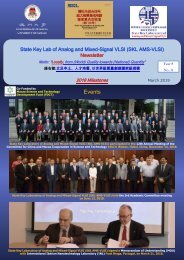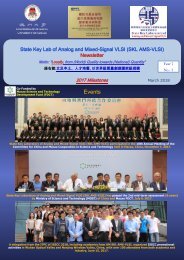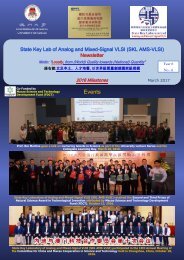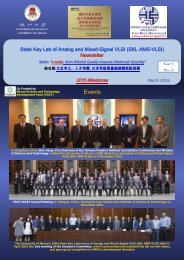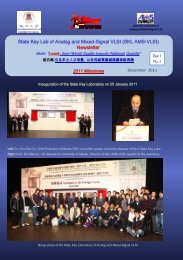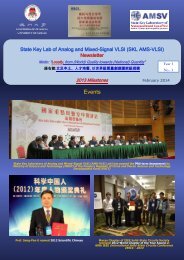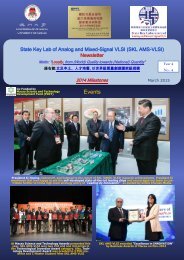IME Newsletter 2019
IME Newsletter 2019
IME Newsletter 2019
You also want an ePaper? Increase the reach of your titles
YUMPU automatically turns print PDFs into web optimized ePapers that Google loves.
Selected works from each research line
In ISSCC 2019 and JSSC 2020
27.3 A Piezoelectric Energy-Harvesting Interface Using Split-Phase
Flipping-Capacitor Rectifier and Capacitor Reuse Multiple-VCR SC
DC-DC Achieving 9.3× Energy-Extraction Improvement
Zhiyuan Chen, Yang Jiang, Man-Kay Law, Pui-In Mak, Xiaoyang Zeng, and Rui P. Martins
From Wireless research line
Motivation
Architecture
Piezoelectric energy harvesters (PEH) exhibit promising features
to scavenge the ambient vibration energy for ubiquitous miniaturized
Internet of Things (IoT) devices. For the traditional PEH using
the full-bridge rectifier (FBR), the PEH inherent capacitance (C p )
limits the extractable AC-DC electrical power. Even though PEH
interfaces employing non-linear techniques such as the parallelsynchronized-switch
harvesting-on-inductor (P-SSHI) can increase
the harvestable energy by extending the damping duration, they
typically require bulky external high-Q inductors to enhance the
extracted power. Recently, various inductor-less PEH interfaces
exploiting only capacitors for flipping the PEH voltage during the
zero-crossing of the PEH current (I p ) have been reported. However,
their achievable energy extraction improvement highly depends
on the number of flipping phases. This work proposes a splitphase
flipping-capacitor rectifier (SPFCR) implementation entailing
only 4 capacitors, while achieving the highest number of phases
(21) when compared with the recent art. To resolve the lack of
input power (P in ) adaptability, this work proposes a capacitorreuse
multiple voltage conversion ratio (VCR) switched-capacitor
(SC) DC-DC converter to reduce the charge redistribution loss.
Maximum power point tracking (MPPT) is also accomplished using
the fractional FBR open circuit voltage (V OC,FBR ) for relaxed voltage
tolerance, while raising the PEH extracted energy. This work
demonstrates a measured 9.3x energy-extraction improvement
when compared with the conventional FBR interface.
Result I
Result II
Verification:
Performance Comparisons:



